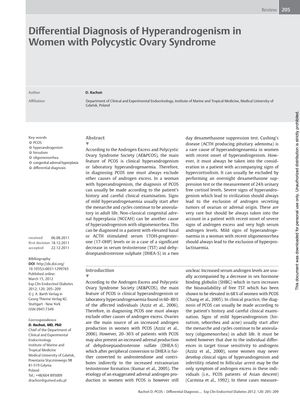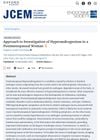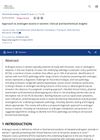Differential Diagnosis of Hyperandrogenism in Women with Polycystic Ovary Syndrome
March 2012
in “
Experimental and Clinical Endocrinology & Diabetes
”
hyperandrogenism Polycystic Ovary Syndrome PCOS DHEA-S non-classical congenital adrenal hyperplasia NCCAH Cushing's disease androgen-secreting tumors serum 17-hydroxyprogesterone ACTH stimulation test dexamethasone suppression test ovarian hyperthecosis hyperprolactinemia hypothyroidism idiopathic hirsutism serum basal 17-OHP total testosterone TST serum prolactin serum 17-OHP

TLDR The conclusion is that accurately identifying the cause of high androgen levels in women with PCOS is crucial and requires specific tests.
The document highlights the importance of accurately diagnosing the cause of hyperandrogenism in women who may have Polycystic Ovary Syndrome (PCOS). It explains that while 60-80% of women with PCOS have clinical or laboratory signs of hyperandrogenism, primarily from the ovaries, 20-30% may have increased adrenal production of DHEA-S. The paper outlines diagnostic approaches for conditions like non-classical congenital adrenal hyperplasia (NCCAH), Cushing's disease, and androgen-secreting tumors, and emphasizes the need for specific tests such as serum 17-hydroxyprogesterone levels, ACTH stimulation tests, and dexamethasone suppression tests. It also discusses the prevalence of NCCAH in certain ethnic groups and the importance of screening. The document notes that severe hyperandrogenism and virilization should raise suspicion for androgen-secreting tumors, especially with a recent onset of symptoms and very high serum androgen levels. Additionally, it covers the diagnosis of other conditions like ovarian hyperthecosis, hyperprolactinemia, hypothyroidism, and idiopathic hirsutism, and the importance of measuring serum basal 17-OHP, total testosterone (TST), and DHEA-S levels, as well as evaluating serum prolactin in certain cases. The review did not specify the number of people studied and did not report any conflicts of interest or specific funding.




